Ten Inconvenient Truths About Ukraine Largely Ignored by the Media

All Global Research articles can be read in 51 languages by activating the Translate Website button below the author’s name.
To receive Global Research’s Daily Newsletter (selected articles), click here.
Follow us on Instagram and Twitter and subscribe to our Telegram Channel. Feel free to repost and share widely Global Research articles.
First published on January 17, 2023
***
As this is a lengthy post, it is divided into the following sections. So, feel free to jump to your area of interest first or navigate around as you wish.
- Introduction
- 1. NATO’s expansion towards Russia’s borders
- 2. The Maidan Coup & Victoria Nuland’s “Fuck the EU”
- 3. Joe Biden bragging about how he got a Ukrainian prosecutor fired who was investigating an energy firm that had Hunter Biden on its board
- 4. Biological Weapons Production Facilities
- 5. Ukraine’s neo-Nazi Azov Battalion
- 6. Zelenskyy’s hidden fortune
- 7. Human Rights abuses committed in Ukraine
- 8. Zelenskyy changing laws to suppress Free Speech
- 9. Suppression of the Church
- 10. Ukraine’s Systemic Corruption Problem
- Conclusion
Introduction
There is no doubt, war is ugly. Atrocities are committed by all belligerents involved in conflict.
Propaganda is heightened and intensified not only by the major participants, but also by countries, governments, organisations, corporations, and individuals who aren’t directly involved in the conflict. Each has their own motivations, reasons, and self-serving interests for doing so.
Fog of war – a German expression Nebel des Krieges coined by Prussian general Carl von Clausewitz – is often used to describe the uncertainty in situational awareness experienced by participants in military operations.
The expression can also easily be used to describe the fog that occurs between people’s ears when they are bombarded with propaganda pushed by countless parties which most often completely distorts the true realities of the conflict or war in question.
War is emotional. And when emotions are high and people are gaslighted, reason and judgement are often easily thrown out the window.
The absence or omission of truthful information and picking sides also contribute to a lack of balanced reporting on such conflicts.
Too often, the very powerful mainstream press is incentivised to report a prevailing narrative that, more often than not, serves the vested interests of those to whom they are all too willing to oblige their allegiances to.
Journalists and independent or alternative media outlets that provide reporting that is counter to these prevailing narratives are often labelled as conspiracy theorists or other derogatory labels.
This is done so because those who are attacking them cannot counter the merits of their claims and reporting, and thus must resort to attacking their character instead.
Unfortunately, this is a logical fallacy that most of the general public fall for.
Now for the ugly, inconvenient, truths that the mainstream media refuse to present to their audiences with regards to the Ukraine and the Russia-Ukraine war.
1. NATO’s expansion towards Russia’s borders
For those not entirely familiar with NATO, or the North Atlantic Treaty Organization, here is a nice summary by Al Jazeera:
“The North Atlantic Treaty Organisation (NATO) was founded in 1949 by 12 member states – Belgium, Canada, Denmark, France, Iceland, Italy, Luxembourg, the Netherlands, Norway, Portugal, the United Kingdom and the United States – and was established to curb Soviet expansion and encourage political integration in Europe in the aftermath of World War II.
The 30-member alliance is meant to guarantee political and military protections, and allow European and North American nations to discuss security concerns.”
One of the main reasons for its existence was to “curb Soviet expansion”, as stated above. The rationale being that the West viewed the Soviet communist system as a grave threat after World War II.
Moreover, as the Soviet Union and the United States were embroiled in the Cold War from 1947 to 1991, the U.S. sought to expand its sphere of political and military influence, particularly in Europe.
After the Dissolution of the Soviet Union in 1991, 15 former Soviet Republics became sovereign states.
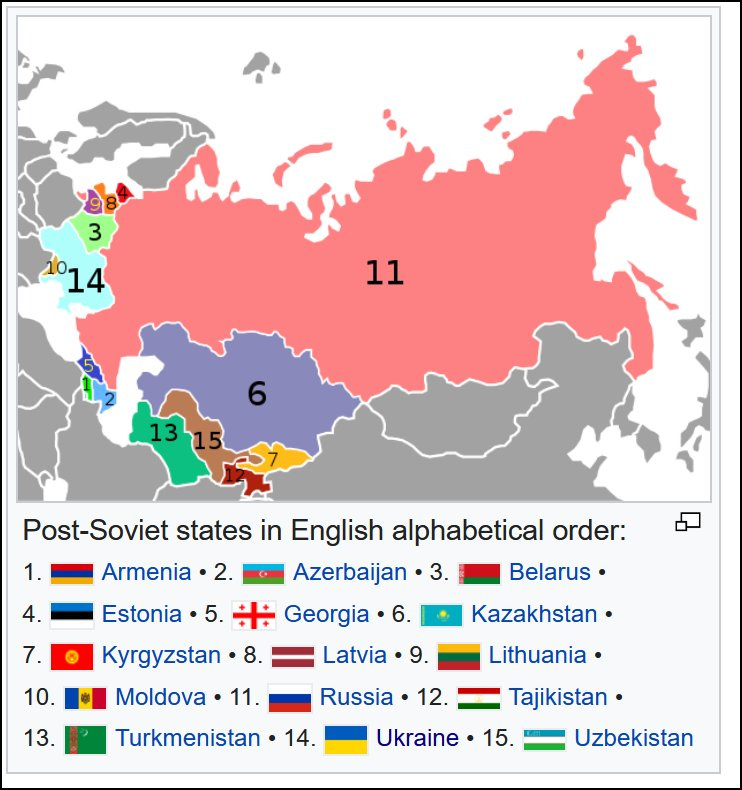
Fifteen post-Soviet states. Source: Wikipedia.
Though many of these states as well as their people have retained close ties with Russia, three of them acceded membership into NATO in 2004; namely, Estonia, Latvia, Lithuania.
Two of these countries, Estonia and Latvia share a border with Russia.
Recall that NATO originally had 12 members.
A CNBC article provides two maps showing the expansion of NATO since 1991 towards Russia. The first map shows Europe in 1990, the year after the Berlin wall fell:
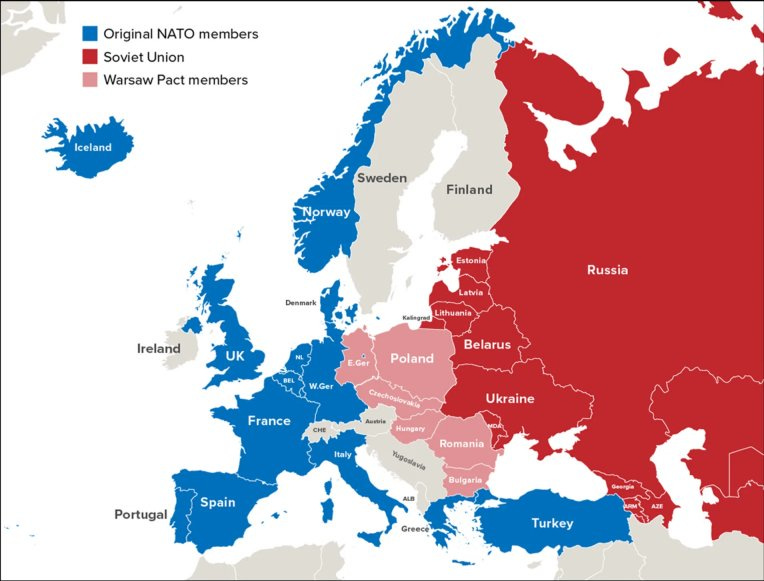
Map of Europe in 1990 showing original NATO countries in blue. Source: Bryn Bache, CNBC.
Their second map, as of 2022, clearly shows the expansion of NATO membership over the past 32 years since the reunification of Germany:

Map of Europe in 2022 showing current NATO countries in blue. Source: Bryn Bache, CNBC.
From this second map above showing 2022 NATO countries in blue, we can also notice Sweden and Finland (in light blue) who are currently vying for NATO membership.
Since the early 1990s, Russia has been worried about NATO expanding closer to its borders.
While various agreements had been made between Russia and Europe not to expand NATO eastward, several of them were broken.
The main worry is that NATO members can have military bases that hold nuclear missiles for which member countries, such as the United States, have an ample supply of.
There is plenty of evidence that confirms that such military bases (particularly from the U.S. and NATO) exist and are located in Russia’s immediate neighbors of Estonia(see also here, here and here), Latvia (see also here, here, here, here, here, here, and here) , and Lithuania (see also here, here, here, here, and here).
U.S. and NATO military bases, personnel, and operations are not limited to these three countries, for there are many more in other NATO countries near Russia such as Poland, Hungary, and Bulgaria.
In recent years, Russian President Vladimir Putin has sought guarantees from NATO and many of its European members that it would halt its eastward expansion and end military cooperation with Ukraine and Georgia, which are not members, observed Al Jazeera.
Both Georgia and the Ukraine share borders with Russia and the latter has a significantly long border with the biggest former member of the Soviet bloc.
It would thus come as no surprise that Russia and its current leader, Vladimir Putin, would consider it more than hostile should either of these two countries were to join NATO.
Many of sound mind would argue that having military bases, some with nuclear arsenals, within only several kilometers from your doorstep poses a significant threat to the safety, protection, and territorial integrity of a nation and its people.
Was this not the case when the Soviet Union had stationed nuclear missiles in Cuba, less than 100 miles away from the United States?
If that was not acceptable to President John F. Kennedy and the U.S. administration, then how is it different for Vladimir Putin, the President of Russia and his administration?
Should they not be granted the same right?
These questions must be considered and contemplated prior to outrightly accusing Putin of “aggression” and invasion against the Ukraine, or any other close neighbor, for that matter.
Also according to the Al Jazeera article, in February [of 2022], Putin said Russia’s “special operation” in Ukraine was a means to stop NATO’s growth, which he perceives as an encroachment.
Only in recent weeks has Putin called the conflict with the Ukraine a war. Perhaps this is so because he had not anticipated the level and extent of Western support Kiev has received over the past year.
While some would argue that the invasion was nevertheless unjustified, ample evidence exists that show that prior promises and agreements to not allow the expansion of NATO eastward were broken by NATO members and NATO itself.
Here are but two of these broken promises which most everyone seems to forget about.
Early last year, a secret document from March 1991 titled QUADRIPARTITE MEETING OF POLITICAL DIRECTORS, BONN, 6, MARCH: SECURITY IN CENTRAL AND EASTERN EUROPE showed a pledge to Moscow by the United States, Germany, France, and the United Kingdom, that they would not extend NATO eastward and would not offer membership to Poland.
The document was found in the UK National Archives by Joshua Shifrinson, a political science professor at Boston University in the US and shared with Der Spiegel. It had been marked “Secret” but was declassified at some point.
Specifically, here is part of what was it stated:
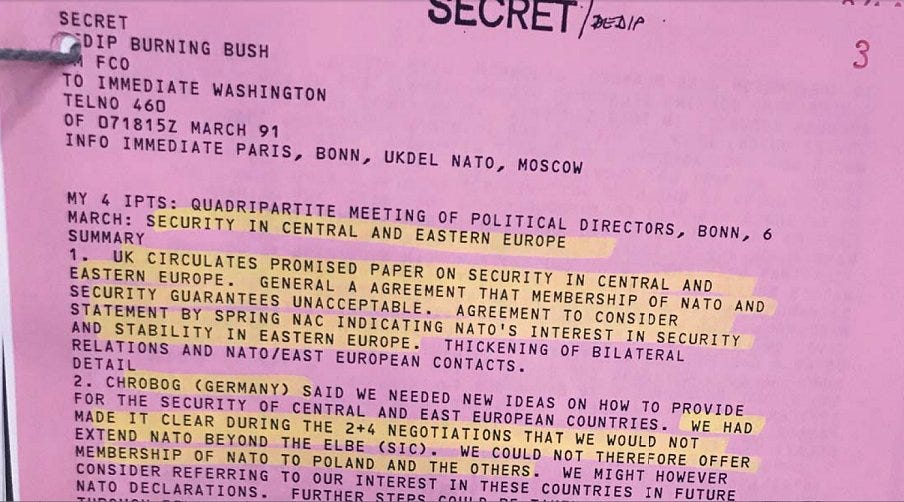
Screenshot of the 1991 QUADRIPARTITE MEETING OF POLITICAL DIRECTORS, BONN, 6, MARCH: SECURITY IN CENTRAL AND EASTERN EUROPE. Source: UCLA College of Social Sciences.
As the reader may notice from the image above, the parties stated: “WE HAD MADE IT CLEAR DURING THE 2+4 NEGOTIATIONS THAT WE WOULD NOT EXTEND NATO BYOND THE ELBE (SIC).”
The “2+4 negotiations” simply refers to the reunification of Germany (i.e., East Germany with West Germany) with NATO remaining an integral part of the reunified country.
In July 2014, NATO itself called the eastward expansion a “myth,” as per its published piece titled NATO enlargement and Russia: myths and realities. In that piece, a few questions were raised about the “enlargement conundrum” [emphasis added]:
“Does the absence of a promise not to enlarge NATO mean that the West never had any obligations vis-à-vis Russia? Did the enlargement policy of Western institutions therefore proceed without taking Russian interests into account? Again, the facts tell a different story.”
The only thing is, NATO was not counting on the QUADRIPARTITE MEETING OF POLITICAL DIRECTORS, BONN, 6, MARCH: SECURITY IN CENTRAL AND EASTERN EUROPE secret document to be released to the public.
In black and white, it confirms that a promise, or agreement, by NATO not to expand did take place.
So, this myth, or “conspiracy theory” turned out to be conspiracy fact.
It is no wonder that Moscow and Putin hold a fervent distrust of NATO, the United States, and its other Western allies.
The secret 1991 document also revealed the following:
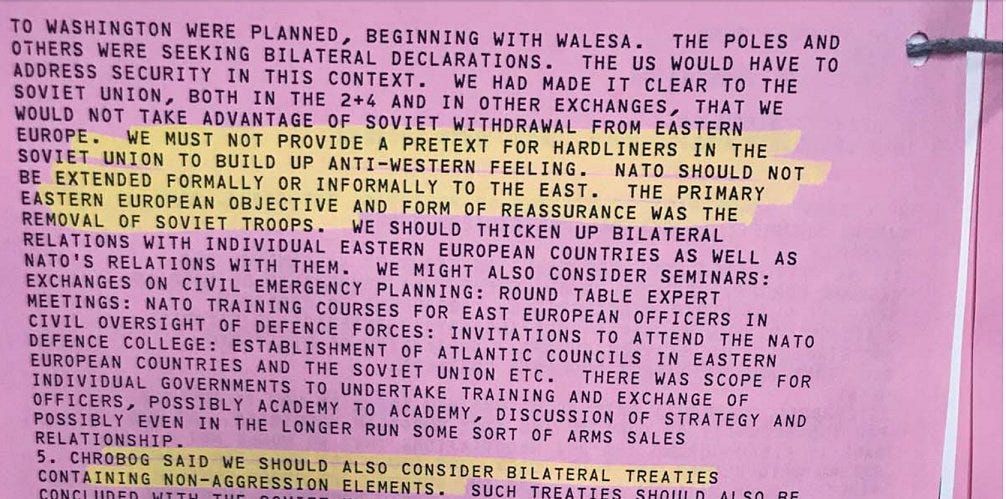
Verbatim [with emphasis added for the most salient points]:
“WE HAD MADE IT CLEAR TO THE SOVIET UNION, BOTH IN THE 2+4 AND IN OTHER EXCHANGES, THAT WE WOULD NOT TAKE ADVANTAGE OF SOVIET WITHDRAWAL FROM EASTERN EUROPE. WE MUST NOT PROVIDE A PRETEXT FOR HARDLINERS IN THE SOVIET UNION TO BUILD UP ANTI-WESTERN FEELING. NATO SHOULD NOT BE EXTENDED FORMALLY OR INFORMALLY TO THE EAST. THE PRIMARY EASTERN EUROPEAN OBJECTIVE AND FORM OF REASSURANCE WAS THE REMOVAL OF SOVIET TROOPS.”
As you can see, the promise was indeed made. The Soviet withdrawal did occur. Yet NATO expanded anyhow, including in Poland for which they had also explicitly stated they would not.
If NATO has lied about this broken promise, then how many others have they lied about and broken? And, more importantly, should they be trusted?
That is not the only promise NATO has broken with Russia.
The Minsk agreement of 2015
“The Minsk agreement, which the Russian government backed for diplomatic reasons, has served to allow Washington time to train, equip, and mobilize much stronger forces now preparing to resume the attack on Donetsk and Luhansk,” observed Dr. Paul Craig Roberts, former U.S. Assistant Secretary of the Treasury, former associate editor at The Wall Street Journal, and long time Russia connoisseur, back in 2015.
He was right.
What is the Minsk agreement?
Not to be confused with the 1991 agreement of the same name, the 2015 Minsk agreement was one that aimed to resolve the long-simmering conflict in eastern Ukraine.
The conflict was between pro-Russian separatists mostly from the Donetsk and Luhansk regions who were more ethnically Russian and the Ukrainian government.
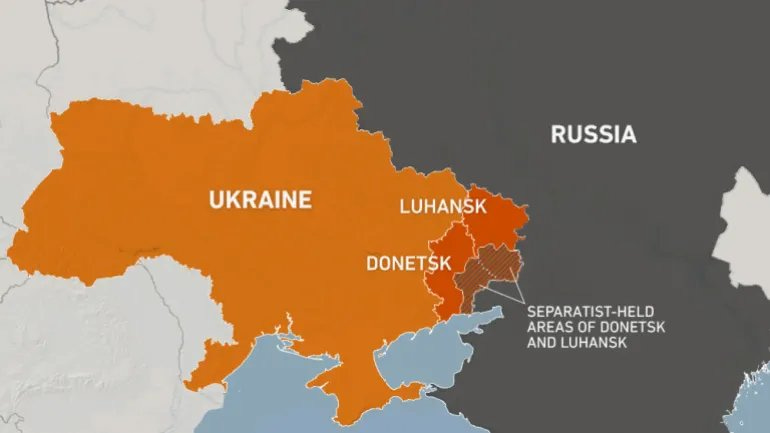
Image source: Al Jazeera.
The following passage from Reuters describes the 2015 (Minsk II) agreement in a nutshell:
“Representatives of Russia, Ukraine, the Organisation for Security and Cooperation in Europe (OSCE) and the leaders of two pro-Russian separatist regions signed a 13-point agreement in February 2015 in Minsk. The leaders of France, Germany, Russia and Ukraine gathered there at the same time and issued a declaration of support for the deal.”
The agreement ultimately failed.
While which side is the blame is a contentious matter, the Organisation for Security and Cooperation in Europe (OSCE), who was in charge of monitoring the implementation of the ceasefire agreement, determined that the Ukrainian government had repeatedly violated the agreement and around 200 weekly violations in 2016-2020 and more than 1,000 since 2021 occurred, according to Novaya Gazeta.
Though NATO stressed that the Minsk agreements remained “the best chance to settle the conflict,” its actions proved otherwise.
Back in 2015, Jens Stoltenberg, NATO’s Secretary General since 2014, indicated no less than an increase military support to the Ukraine during this so-called ceasefire period, stating “we have stepped up our support to Ukraine on command and control; logistics; cyber defence.”
And more specifically, in June of 2022, Stoltenberg affirmed NATO’s long-time push into Eastern Europe, stating:
“the reality is that we have also been preparing for this since 2014. Because that’s the reason why we have increased our presence in the eastern part of the Alliance, why NATO Allies have started to invest more in defence, and why we have increased the readiness.”
By “increase in the readiness”, Stoltenberg was referring to Russia. On the matter, Robert Bridge, an American writer and journalist for RT noted:
“What he neglected to mention, though, was the role Western powers played in the outbreak of civil violence in Kiev on February 24, 2014 that led to the Maidan coup and, ultimately, to the current situation. The US and its influence on the ground in Ukraine, channelled through “civil society” groups it bankrolled, was largely responsibility for that mess.”
A month before the Russian invasion in 2022, Ukraine’s own security chief, Oleksiy Danilov, warned the West against enforcing the Minsk II peace deal.
Danilov also denounced the Russian demands for NATO to bar Ukraine from ever joining the alliance.
Former opposition MP Ilya Kiva (who had to flee the Ukraine for his stark opposition to Zelenskyy) blamed the Ukrainian President of supporting pro-NATO policies causing the war, allowing Nazism to permeate in the country, and enslaving his own people in the eastern part of the country.
In a March 2022 interview Kiva slammed the U.S. and NATO for “using Ukraine as bait to provoke Russia into a conflict.” He added that Washington and its allies had tricked Zelenskyy which has led to its current state of devastation.
In concluding this section, the Minsk agreements were practically doomed from the start since powerful forces influencing Kyiv, including NATO and many others mentioned in this exposition, really had no sincere interest in helping to establish peace in eastern Ukraine; but were more concerned with continuing their eastward expansion towards Russia’s borders.
2. The Maidan Coup & Victoria Nuland’s “F**k the EU”
In the years 2013-2014, the Ukraine was at a real crossroads. Geographically-perched between Europe in the west and Russia in the east, alliances were split and there was a lot at stake – economically and geopolitically.
The West was calling for the young country to align itself with European and American interests.
But its President, democratically-elected Ukrainian President Viktor Yanukovych, was instead leaning towards aligning the country’s interests with Russia and Putin.
This was absolutely unacceptable to Western powers and NATO.
Consequently, Ukrainian President Viktor Yanukovych was overthrown in a violent coup on Feb. 21, 2014.

Violence during the Maidan coup in Ukraine, 2014. Source: Wikipedia.
This operation is more commonly known as the Maidan Coup in which demonstrators (against Yanukovych’s government) leadership were riddled with neo-Nazis.
A phone call (transcript here) was leaked to the news media on February 4th, 2014 between U.S. Assistant Secretary of State Victoria Nuland and Geoffrey Pyatt, the then U.S. ambassador to Ukraine.
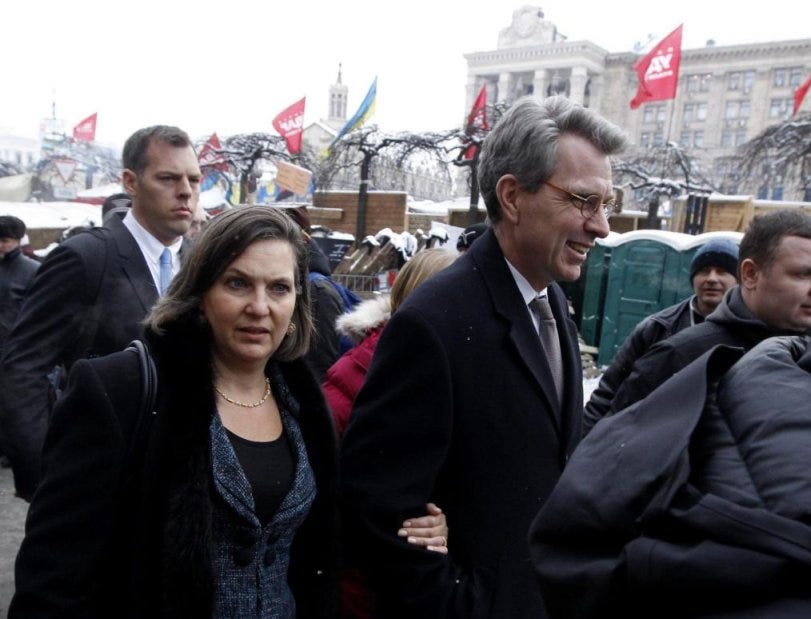
Assistant Secretary of State Victoria Nuland with Geoffrey Pyatt, February 6, 2014.
During the call, they discussed which puppets could be installed in their new government; keep in mind, this is a few weeks before the Maidan Coup had occurred.
Nuland and Pyatt schemed on how they would form the new government post-coup placing “Yats”, Arseniy Yatseniuk as a key plant for the new government.
Arseniy Yatseniuk became the new Prime Minister of Ukraine on February 27, 2014.
And in June of the same year, NATO- and Western-friendly Ukrainian oligarch Petro Poroshenko replaced Yanukovych as the new President of Ukraine in what was a very questionable election.
This phone call is also memorable for its “Fuck the EU” reference uttered by Victoria Nuland. This was in reference to her frustration about how members of the European Union were somewhat divided on relations with Russia and thus not aggressive enough against their Cold War rival.
3. Joe Biden bragging about how he got a Ukrainian prosecutor fired who was investigating an energy firm that had Hunter Biden on its board
According to Consortium News, after the U.S.-led coup, Viktor Shokin, Ukraine’s prosecutor general, was investigating corruption allegations about Burisma holdings, a Ukrainian oil & gas giant for which Hunter Biden had been given a lucrative membership to sit on its board of directors.
Threatening to pull a U.S. billion-dollar aid package to the Ukraine, then Vice-President Joe Biden forced Ukrainian President Poroshenko to fire Shokin.
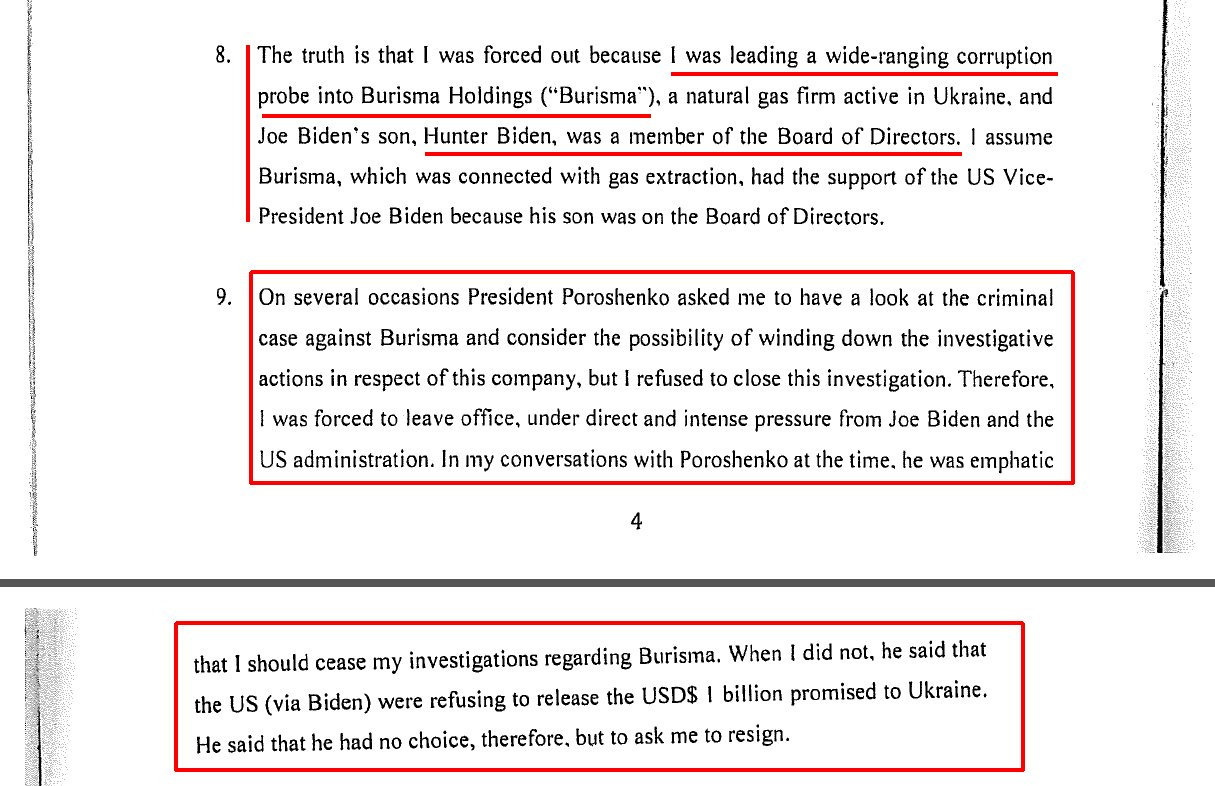
Screenshot of the Witness Statement (affidavit) from Viktor Shokin, who was investigating corruption at Burisma Holdings, confirming that Poroshenko fired him because of Joe Biden’s threat to pull the USD$1 billion package.
In January 2018, Biden openly bragged about this at the Council on Foreign Relations:
Alternative video link: https://rumble.com/vc5gnj-joe-biden-admits-quid-pro-quo-with-ukraine.html
Hunter Biden was paid handsomely, to the tune of $80,000 per month, despite having no experience whatsoever in the energy sector. It was thus presumed that he was on the board mostly because of his name and political ties, particularly with his father who was President Obama’s Vice-President at the time.
Though the mainstream press has largely exonerated Hunter Biden regarding his role and actions with Burisma, the New York Post did provide evidence which shows that Hunter had indeed introduced one of its board members to his Vice-President father.
The fact that Joe Biden leveraged the power of his V.P. position to avoid having an investigation into the firm for which his son was a board member represents a clear abuse of power and conflict of interest. Who knows what additional facts might have been revealed should the investigation have proceeded. The next section, however and nonetheless, provides damning evidence in this regard.
What’s more, this incident exemplifies the power and influence the U.S. Administration had over the President of Ukraine post the Maidan coup.
4. Biological Weapons Production Facilities
The corporate media has also largely ignored claims alleging the existence of biological weapons laboratories across the Ukraine.
In the month after Russian forces launched their invasion of Ukraine, Lieutenant General Igor Kirillov, commander of the Russian radiological, chemical and biological defense force, claimed that as many as 30 biological laboratories had been established in Ukraine that are actively cooperating with the US military; and that the Ukrainian authorities have been urgently destroying pathogens studied at its laboratories linked to the US Department of Defense.

Map showing some biolabs in the Ukraine, image source: Polish Sputnik – Nowe doniesienia o amerykańskich projektach dotyczących broni biologicznej na Ukrainie (google translated: New reports on US bioweapons projects in Ukraine)
China also accused the U.S. military of operating such biolabs in the Ukraine which Bloomberg brushed off as a conspiracy theory.
On March 8, 2022, American ally Britain also downplayed the story alleging that they were fabricated to justify Russia’s invasion of the Ukraine.
Yet, hours later Victoria Nuland (the same mentioned above), acting as Undersecretary of State admitted that such facilities existed stating:
“Ukraine has biological research facilities which, in fact, we’re now quite concerned Russian troops, Russian forces may be seeking to gain control of, so we are working with the Ukrainians on how we can prevent any of those research materials from falling into the hands of Russian forces should they approach.”
And though the U.S. State Department two days later denied any involvement in their operations, evidence suggests otherwise.
On the subject Glenn Greenwald outlined the extent to which the legacy media were in full damage-control, labelling all those reporting on the matter as crazy conspiracy theorists and peddlers of misinformation. Greenwald began his piece with [original links included]:
“Self-anointed “fact-checkers” in the U.S. corporate press have spent two weeksmocking as disinformation and a false conspiracy theory the claim that Ukraine has biological weapons labs, either alone or with U.S. support. They never presented any evidence for their ruling — how could they possibly know? and how could they prove the negative? — but nonetheless they invoked their characteristically authoritative, above-it-all tone of self-assurance and self-arrogated right to decree the truth and label such claims false.”
Greenwald reiterated the fact that Nuland had indeed never denied the existence of the labs and, in fact, was quite worried about how their materials could “fall into the hands of Russian forces,” to which he posited some highly relevant questions [emphasis added]:
“What is in those Ukrainian biological labs that make them so worrisome and dangerous? And has Ukraine, not exactly known for being a great power with advanced biological research, had the assistance of any other countries in developing those dangerous substances? Is American assistance confined to what Nuland described at the hearing — “working with the Ukrainians on how they can prevent any of those research materials from falling into the hands of Russian forces” — or did the U.S. assistance extend to the construction and development of the “biological research facilities” themselves?”
Greenwald also points out how the U.S. State Department downplays its role with the biolabs in the Ukraine, stating that they are merely for research purposes and for reducing biological threats. Yet, fact sheets on their website demonstrate millions in funding and for the specific purpose of building facilities and providing training.
Ukraine Biolab Funding via Hunter Biden’s entities
A bombshell report by the U.K.’s DailyMail provides ample evidence that corporate entities related to Hunter Biden have funded biolabs in the Ukraine. And, in this respect, there is even a connection to the aforementioned Burisma Holdings.
As per the DailyMail’s March 25, 2022 article title ‘EXCLUSIVE: Hunter Biden DID help secure millions in funding for US contractor in Ukraine specializing in deadly pathogen research, laptop emails reveal, raising more questions about the disgraced son of then vice president’, we find a treasure trove of emails and documents that provide solid evidence of funding activities for these bioweapons lab in the Ukraine.
The article begins with a mention of a U.S. Department of Defence (DoD) contractor called Metabiota which specialises in researching pandemic-causing diseases that could be used as bioweapons. Sound familiar?
So, it appears that the previously mentioned claims by the Russian General that biological laboratories had been established in Ukraine and are actively cooperating with the US military certainly appears to be founded in reality, rather than some tall conspiracy tale.
The Russian Commander also claimed that their funding arose from the current U.S. leadership; and, in particular, from the investment fund Rosemont Seneca which is headed by none other than Hunter Biden.
As per a November 14, 2019 ZeroHedge article, Rosemont Seneca is a corporation controlled by Hunter Biden and his business partner Devon Archer. And Rosemont Capital is the parent company of Rosemont Seneca (also sometimes referred to as Rosemont Seneca Technology Partners, or RSTP).
Amidst a U.S. Department of Justice investigation into Hunter Biden’s foreign dealings, even Wikipedia had to do damage control to memory-hole Hunter’s links to Rosemont Seneca.
Here is the Burisma link. Through the Biden emails, it was revealed that Burisma executive Vadym Pozharskyi had sent a thank you email to Hunter for having invited him to [Washington] DC to meet his father, Joe Biden. This corroborates the rationale that Hunter’s presence on Burisma’s board of directors was indeed for his family name and political connections.
Next, the DailyMail leak reveal an email from Vadym Pozharskyi to Devon Archer, Hunter’s business partner at Rosemont Seneca, on the subject of “Ukraine Science.” In the email letter, Pozharskyi expresses his concern about how Metabiota, the DoD subcontractor, seems to have pulled their financing for this “science” project, i.e., biolabs.
At prima facie, an inquiring mind would ponder the reason on why Burisma, a company involved in oil & gas, would be concerned with funding for biolab facilities; for, this would obviously not fall under the scope and nature of the principal activities of an energy company. Unless, of course, this was not the raison d’être for this company in the first place.
Perhaps funding was pulled due to closer scrutiny on these entities, along with the U.S. Department of Justice’s investigation.
Also according to the DailyMail leak, Hunter and his colleagues invested $500,000 in Metabiota through their firm Rosemont Seneca Technology Partners and they raised several million dollars of funding for the company from investment giants including Goldman Sachs.
According to a ZeroHedge article about the same Hunter Biden email leaks, Metabiota was working under Black & Veatch – a US defense contractor tied to US intelligence, which built the Ukraine labs that analyzed bioweapons and deadly diseases.
Black & Veath does appear on some of the aforementioned fact sheets of the U.S. Embassy in Ukraine website, namely: Kherson Diagnostic Laboratory, Ternopil Diagnostic Laboratory, Zakarpartska Diagnostic Laboratory, Lviv Research Institute of Epidemiology and Hygiene, Lviv Diagnostic Laboratory, Kharkiv Diagnostic Laboratory, State Regional Laboratory of Veterinary Medicine Luhansk Regional Diagnostic Veterinary Laboratory, Dnipropetrovsk Diagnostic Laboratory, and Vinnytsia Diagnostic Laboratory.
It is also worth noting that, according to the Kharkiv Diagnostic Laboratory factsheet, a special permit for working with pathogens (i.e., potentially dangerous bioweapons) was issued and Kharkiv, where the Kharkiv Diagnostic Laboratory is located, is only 25 kilometers from the Russian border. This would definitely be cause for concern by the Russian forces, for fear of leak – intentional or not – emanating from this particular facility. The same can be said about the Black & Veath facility in Luhanskwhich sits dangerously close to the Russian border.
Also regarding Metabiota, the DailyMail article noted [emphasis added]:
“Metabiota also has close ties to the Wuhan Institute of Virology (WIV), suspected to be the source of the COVID-19 outbreak.
WIV was a hotspot for controversial ‘gain of function’ research that can create super-strength viruses.
Chinese scientists performed gain of function research on coronaviruses at the WIV, working alongside a US-backed organization EcoHealth Alliance that has since drawn intense scrutiny over its coronavirus research since the COVID-19 pandemic.
Researchers from the Wuhan institute, Metabiota and EcoHealth Alliance published a study together in 2014 on infectious diseases from bats in China, which notes that tests were performed at the WIV.
Shi Zhengli, the WIV Director of the Center for Emerging Infectious Diseases who became dubbed the ‘bat lady’ for her central role in bat coronavirus research at the lab, was a contributor to the paper.
Metabiota has been an official partner of EcoHealth Alliance since 2014, according to its website.”
As for the last claim from the above quote, a simple search on the matter corroborates linkages between EcoHealth Alliance and Metabiota.
Moreover, it has been confirmed that EcoHealth Alliance has indeed been funded to do gain of function research (for deadly pathogens such as SARS-CoV-2).
As this author had noted in the ‘The origins of SARS-CoV-2 (Covid-19)’ section of a previous exposé, it is very possible, and even likely, that SARS-CoV-2 originated from the Wuhan Institute of Virology.
Accordingly, the potential threat of a new pathogen emerging from even one of these facilities in the Ukraine is undoubtedly of paramount concern to the Russians, as it would be with any country.
Finally, it remains unclear as to how the Ukraine benefits from having such biolab facilities, for it inherently poses risks such as accidental leaks as well as possible retaliatory actions by nervous neighbors.
5. Ukraine’s neo-Nazi Azov Battalion
The all-volunteer Azov Battalion is one of Ukraine’s paramilitary groups that was formed in response to the government’s struggle against pro-Russian separatists in the country’s east.
Many of the Azov Battalion members are, even by their own description, socialist ultra-right Ukrainian nationalists.
In terms of their ideology, they are aligned with the Social-National Assembly.
The battalion has adopted many symbols and slogans that are associated with Neo-Naziism.
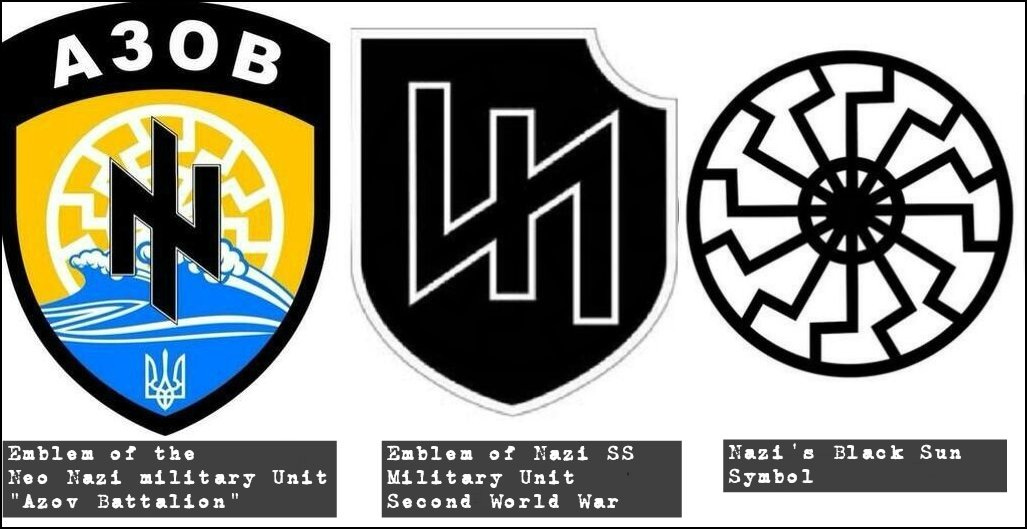
The Nazi symbols used by Ukraine’s Azov Battalion. The first two images include the Wolfsangel hate symbol while the first and third the Sonnenrad (Black Sun) hate symbol. Source: Consortium News.

Picture of Ukrainian soldiers with Nazi symbols on their helmets, including the swastika and the SS. Source: NBC News – German TV Shows Nazi Symbols on Helmets of Ukraine Soldiers, Sept. 9, 2014.
When tensions erupted in April of 2014 in the eastern part of Ukraine – particularly in the Russian-backed regions of Donetsk and Luhansk – the group took on extreme forms of paramilitary tactics and started to receive funding and training from NATO-friendly partners such as the United States, the United Kingdom, and Canada (see sub-section below), amongst others, which continues to this day.
In August of 2014, Tom Parfitt, a correspondent from The Telegraph noted:
“Kiev’s use of volunteer paramilitaries to stamp out the Russian-backed Donetsk and Luhansk ‘people’s republics’ should send a shiver down Europe’s spine.”
“Recently formed battalions such as Donbas, Dnipro and Azov, with several thousand men under their command, are officially under the control of the interior ministry but their financing is murky, their training inadequate and their ideology often alarming. The Azov men use the neo-Nazi Wolfsangel (Wolf’s Hook) symbol on their banner and members of the battalion are openly white supremacists, or anti-Semites.”
And based on interviews with militia members, the Telegraph also reported that some of the fighters doubted the reality of the Holocaust, expressed admiration for Adolf Hitler, and acknowledged that they are indeed Nazis.
At the time, the commander of Azov Andriy Biletsky declared: “The historic mission of our nation in this critical moment is to lead the White Races of the world in a final crusade for their survival. A crusade against the Semite-led Untermenschen.” The German word Untermenschen means sub-human, a supremacist slur.
Back in September of 2014, The Guardian correspondent Shaun Walker reportedalongside Azov Battalion volunteers in Mariupol, the southeastern region of Ukraine. Walker observed [emphasis added]:
“But there is an increasing worry that while the Azov and other volunteer battalions might be Ukraine’s most potent and reliable force on the battlefield against the separatists, they also pose the most serious threat to the Ukrainian government, and perhaps even the state, when the conflict in the east is over. The Azov causes particular concern due to the far right, even neo-Nazi, leanings of many of its members.”
Dmitry, an Azov volunteer he spoke to, “claimed not to be a Nazi, but waxed lyrical about Adolf Hitler as a military leader, and believes the Holocaust never happened.” But perhaps more surprisingly, it is the distaste for their own government that stood out:
“Not everyone in the Azov battalion thinks like Dmitry, but after speaking with dozens of its fighters and embedding on several missions during the past week in and around the strategic port city of Mariupol, the Guardian found many of them to have disturbing political views, and almost all to be intent on “bringing the fight to Kiev” when the war in the east is over.”
There is perhaps no better or intimate way to get into the mindset of the average Azov volunteer than to be embedded with them in the heat of the battle.
Walker also notes that though the Azov Battalion represents a minority among Ukrainian forces, they are not anti-Russian. One of the reasons being that most of their members lingua franca is Russian and that much of what Azov members say about race and nationalism is strikingly similar to the views of the more radical Russian nationalists fighting with the separatist side. He also notes that Azov intends to bring violence to Kiev when the war in the east is over.
“President Petro Poroshenko will be killed in a matter of months,” Azov volunteer Dimitry stated, continuing “and a dictator will come to power.” “What are the police going to do? They could not do anything against the peaceful protesters on Maidan; they are hardly going to withstand armed fighting units,” he concluded.
Dimitry’s prediction turned out to be partly correct, for though Poroshenko was not assassinated, he did get ousted during the Maidan coup and had to flee the country. It remains to be determined whether Poroshenko’s successor, Volodymyr Zelenskyy, is a dictator; but, what features later in this essay may suggest that this has turned out to be the case.
Serving as an internal police force and with the support of the Minister of the Interior, Arsen Avakov, the Azov Battalion played a significant role in the protests amidst the Maidan coup which led to the ousting of President Yanukovych.
Though supposedly a “minor” fringe group amongst paramilitary units in the Ukraine, units such as the Azov Battalion and the Waffen SS organization found widespread support among Ukrainian nationalists, even in Kiev and in the western part of the country.
Many praised Stepan Bandera, a Ukrainian far-right leader who was, together with his followers, responsible for the massacres of Polish and Jewish civilians and has the dishonorable label of being a fascist Nazi collaborator during the periods preceding, during, and following World War II.
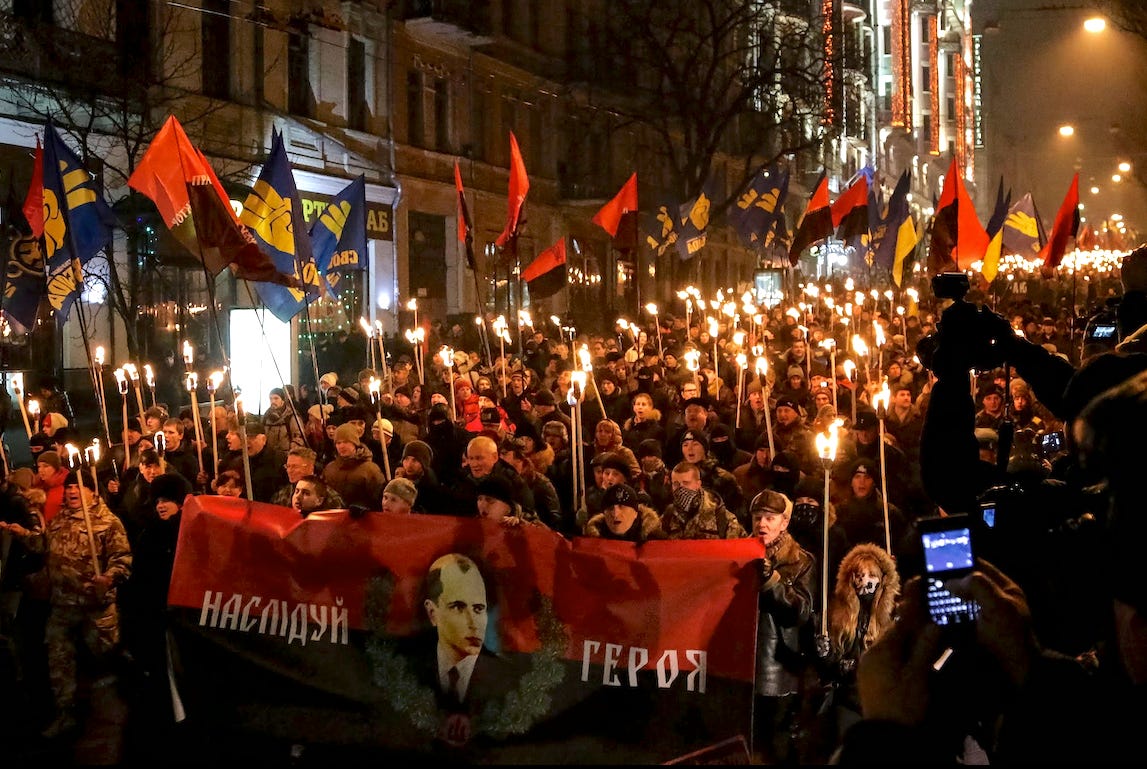
Torchlight march in honor of the anniversary of the birth of Stepan Bandera, Ukrainian wartime fascist leader, Kyiv, January 1, 2015. Photo source: Wikimedia Commons via Consortium News.
In late 2021, reporter Craig Murray from Consortium News made reference to an official report of the U.N. General Assembly plenary of Dec. 16, 2021 which stated [emphasis added]:
“By a recorded vote of 130 in favour to 2 against (Ukraine, United States), with 49 abstentions, the Assembly then adopted draft resolution I, ‘Combating glorification of Nazism, neo-Nazism and other practices that contribute to fuelling contemporary forms of racism, racial discrimination, xenophobia and related intolerance’”
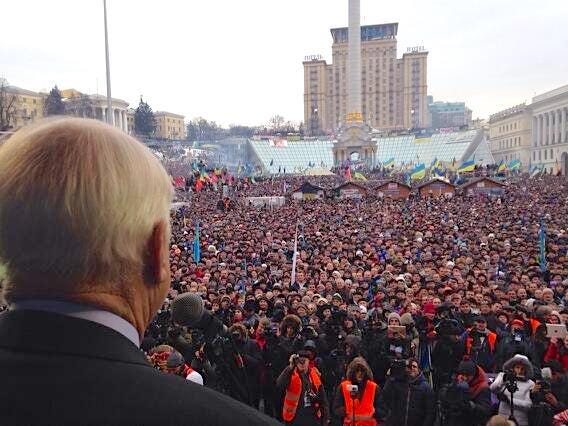
U.S. Senator John McCain addressing a crowd in Kiev on December 15, 2013. Photo source: Wikimedia Commons / U.S. Senate/Office of Chris Murphy via Consortium news.
Even though a 2018 bipartisan letter by 50 U.S. representatives condemned the Ukraine government for glorifying and backing the Nazi groups, the United States vote against the aforementioned UN resolution and has continued to support, and even train, such groups since at least 2013.
Canada’s support for these extreme ultra-nationalist groups
In the following CityNews report from Nov. 10, 2021, extremism researcher Brad Galloway, coordinator from the Centre on Hate Bias & Extremism, expressed concern that far-right Canadians may join the ranks of paramilitary groups such as Azov in the Ukraine.
The report also provides damning evidence about Canada’s diplomatic and military involvement in the training of the Azov Battalion, even though they knew they were a far-right fascist neo-Nazi group.
The report cites an Ottawa Citizen article as well as documents obtained by the news outfit through an Access to Information law which validated the claim, stating [emphasis added]:
“A year before the meeting, Canada’s Joint Task Force Ukraine produced a briefing on the Azov Battalion, acknowledging its links to Nazi ideology. “Multiple members of Azov have described themselves as Nazis,” the Canadian officers warned in their 2017 briefing.””
As per the same article, “Jaime Kirzner-Roberts, policy director of the Friends of Simon Wiesenthal Center [for Holocaust Studies], said Canada had to make it a priority that its military personnel have no involvement with far-right fascist militias in Ukraine under any circumstances, further stating:
“It’s concerning that, for the second time in a month, we have seen evidence of Canadian military officials engaging with Ukrainian neo-Nazi groups.”
Kirzner-Roberts also referred to a report titled ‘Far-Right Group, Made Its Home in Ukraine’s Major Western Military Training Hub’ from the Institute for European, Russian, and Eurasian Studies (IERES) at George Washington University which revealed that Centuria, a far-right group made up of Ukrainian soldiers linked to the Azov movement, boasted they received training from Canada and other NATO countries. The researchers had tracked social media accounts of Centuria documenting its Ukrainian military members giving Nazi salutes, promoting white nationalism, and praising members of Nazi SS units.
The report also confirms Canada’s role, through its UNIFIER military operation, for providing training to Ukraine’s armed forces, as per a statement from Andrii Taran, the Minister of Defence of Ukraine:
“Our Canadian partners are constantly assisting to strengthen the institutional capabilities of Ukraine’s Defence Ministry. Modern principles of defence management and democratic civilian control undergo implementation, and leaders of the strategic and operational levels receive their training. Canada provides all opportunities to improve skills and field training of units of the Armed Forces of Ukraine within the Operation UNIFIER. Therefore, Canada’s key role in training of Ukraine’s defence and security forces is unquestionable,”
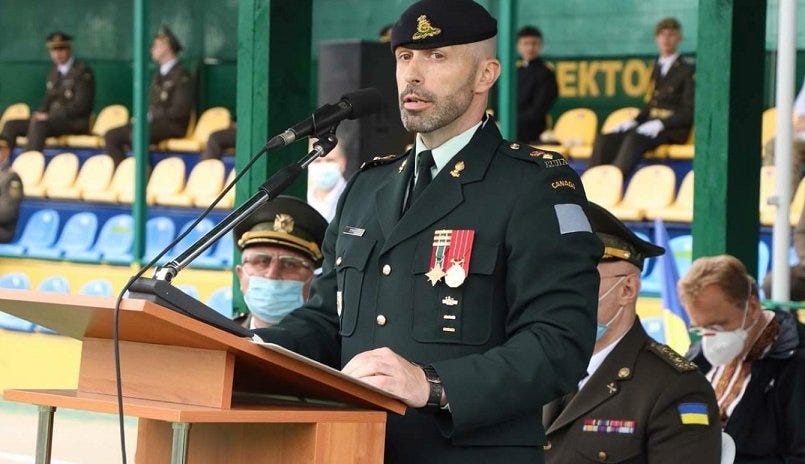
Photo posted to the Canadian Armed Forces in Ukraine Facebook page which shows then Commanding Officer of Canada’s Operation UNIFIER Lieutenant-Colonel Ryan Stimpson speaking at the 2020 NAA graduation ceremony at the International Peacekeeping and Security Center in Yavoriv, Ukraine. Source: The Institute for European, Russian, and Eurasian Studies (IERES) at George Washington University’s ‘Far-Right Group, Made Its Home in Ukraine’s Major Western Military Training Hub’ report.
What is perhaps more troubling with regards to the Canadian military training Ukrainian forces lies with its official response to the mentions of training Ukrainian soldiers from these far-right extremist fascist groups and what their overall approach is [emphasis added]:
“Canadian Forces spokeswoman Lt.-Cmdr. Julie McDonald said it was up to Ukraine to vet its own security forces. But, if Canadian military personnel saw first-hand evidence of extremist views, they could refuse to train those soldiers, she added. The Canadian Forces, however, does not proactively examine the backgrounds of those they train or look for signs of support for far-right causes.”
Notice the word ‘could’ in her statement which would imply that refusing to train the soldiers would be optional and at the discretion of the Canadian military personnel.
This statement was not so different than that from the Canadian Defence Attaché in Ukraine Colonel Robert Foster who stated that when it comes to screening Ukrainian recipients of training for extremist views and ties, Canada trusted the Ukrainian government to select and identify the right candidates; specifically stating: “It is their responsibility.”
Such denialism was brought back to the forefront in April of last year when the Ottawa Citizen reported that Canada failed to properly monitor its own military training program. “Defence sources acknowledged the crest worn by the Ukrainian soldier in Canadian military photos is the insignia of Ukraine’s SS unit which fought for the Nazis,” asserted the report. And yet another Canadian Forces officer, Capt. Véronique Sabourin, affirmed that Ukraine is responsible for vetting its own personnel, shunning responsibility, rather than addressing the highly contentious matter.
The author of this article has contacted the Canadian Armed Forces for comment on the matter. They confirmed that the statement from Capt. Véronique Sabourin from above was accurate, adding “the Canadian Armed Forces are strongly opposed to the glorification of Nazism and all forms of racism, racial discrimination, xenophobia, intolerance and extremism. In all of its international relationships,” stressing that all members “deployed on Operation UNIFIER were briefed to help them recognize patches and insignia associated with right-wing extremism.” Yet, they appeared consistent with their stance stating: “However, and ultimately, Ukraine is a sovereign country and was thus responsible for recruiting and vetting its own security forces.”
Even amidst the complexity involved in screening members of foreign forces for military training, for the Canadian Armed Forces to maintain such a stance whereby they are seemingly willing to turn a blind eye to such far-right extremist groups should put into question Canada’s role, financial, and military contributions regarding this external conflict.
6. Zelenskyy’s hidden fortune
While numerous reports online vary widely in terms of the actual net worth of Volodymyr Zelenskyy as well as the means by which he amassed his fortune, at least tens of millions of dollars worth are traceable.
Beginning with a report from Headlines & Global News (HNGN), Zelenskyy co-owned the television entertainment firm Kvartal 95 which he co-founded in 2003; and, according to Volodymyr Landa, deputy editor-in-chief of Forbes Ukraine, the company earns between $20 and $30 million per year, with Zelenskyy owning a 25% interest. Roughly speaking, that could amount to a conservative figure of $100 million or more for Zelenskyy’s stake since 2003, of course, depending on the net income of the firm.
“On the campaign trail, Zelenskiy pledged to clean up Ukraine’s oligarch-dominated ruling system. And he railed against politicians such as the wealthy incumbent Petro Poroshenko who hid his assets offshore,” noted an October 3, 2021 article from The Guardian which delved into the President Zelenskyy’s offshore connections.
The article references the Pandora papers which were leaked to the International Consortium of Investigative Journalists (ICIJ) and shared with the Guardian as part of a global investigation which suggests that Zelenskiy is “rather similar to his predecessors.”
It mentions that the files reveal Zelenskyy participated in a sprawling network of offshore companies, co-owned with his long-time friends and TV business partners, including Ivan Bakanov who was general director of the previously mentioned production studio, Kvartal 95.
And though Zelenskyy had declared some of his private assets before becoming President, including Film Heritage, the Pandora papers reveal he had other assets stored offshore.
Film Heritage had a 25% stake in Davegra, a Cyprus holding company which in turn owns Maltex Multicapital Corp, a previously unknown entity registered in the tax haven of the British Virgin Islands (BVI). Zelenskyy held a 25% stake in Maltex.
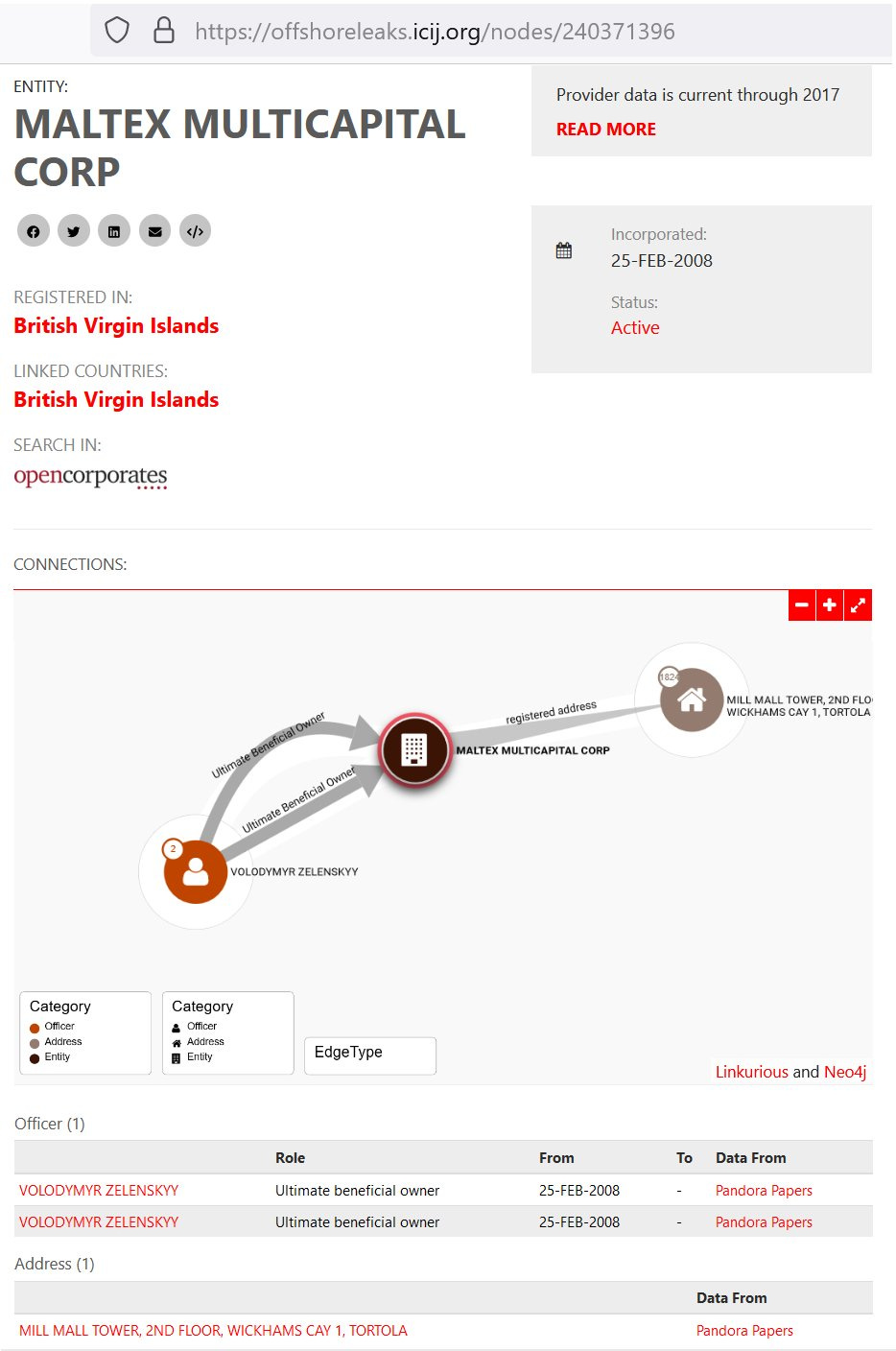
International Consortium of Investigative Journalists (ICIJ) – data from the OFFSHORE LEAKS DATABASE for the entity MALTEX MULTICAPITAL CORP.
According to the Organised Crime and Corruption Reporting Project (OCCRP) report titled Pandora Papers Reveal Offshore Holdings of Ukrainian President and his Inner Circle, though around the time of his 2019 election, Zelenskyy handed his shares in a key offshore company over to Serhiy Shefir (his former TV producer and First Assistant to his current Presidency), the two appear to have made an arrangement for Zelensky’s family to continue receiving money from the offshore entity. As per The Guardian article [emphasis added]:
“Roughly six weeks later, after Zelenskiy’s landslide victory, a lawyer acting for the Kvartal 95 group signed another document. It stipulated that Maltex would continue to pay dividends to Zelenskiy’s Film Heritage, even though it no longer owned any stake in the company. Its main revenue comes from activity in Ukraine, Russia and Belarus, according to a Maltex client profile.”
“Zelenskiy’s wife, Olena, is now the declared beneficial owner of Film Heritage, meaning any payments since 2019 would have flowed to her.”
Notice from the above citation that Zelenskyy, or at least his wife Olena, is still receiving funds from Film Heritage’s operations, including in Russia, their stated bitter enemy.
The OCCRP report also states that offshore companies were used by Shefir and another business partner to buy three expensive London real estate properties, including a three-bedroom flat on Glentworth Street, bought for 1.58 million pounds ($2.28 million), and two-bedroom flat nearby in Baker Street’s Chalfont Court building, which was bought by Shefir for 2.2 million pounds (US$3.5 million).
According to an article from Euromaidan Press, a Ukraine-based English-language independent newspaper, which was largely sourced by a team of a team of independent investigative journalists from Slidstvо.Info, it was revealed that Zelenskyy had strong ties to the Ukrainian oligarch Ihor Kolomoiskyi, as per further examination of the Pandora papers. They discovered a network of interlinked offshore entities by Zelenskyy and his partners, specifically:
“Among the persons named in the documents of offshore registrars that became known thanks to Pandora Papers, journalists feature the names of Ukraine’s state leadership, such as Ivan Bakanov, Head of Security Service of Ukraine, Serhii Shefir, First Assistant to the President, and President Zelenskyy.”
Ivan Bakanov who is the Head of Security Service of Ukraine and a close friend to Zelenskyy, used his power to prevent the screening of the film Offshore 95 by Slidstvo.Info which showcased the extent of the corruption of Zelenskyy and his close friends and business partners, including Ihor Kolomoisky, the powerful Ukrainian banking oligarch.
Slidstvо.Info film “OFFSHORE 95” Secrets of the President Zelenskyy’s business, Oct. 3, 2021
The team of investigative journalists had also discovered that around a dozen persons in Zelenskyy’s inner circle have offshore companies, and that the offshore registrar Fidelity and Ukrainian lawyer Yurii Azarov helped create the network. What’s more, they also revealed that [emphasis added]:
“The Pandora Papers disclosed that since 2012, an offshore company affiliated to Kolomoiskyi’s 1+1 group at least once paid more than $1 billion to Zelenskyy’s offshore firm SVT from the British Virgin Islands, for the popular TV show “Make a Comedian Laugh” created by Kvartal 95. And Maltext owns half of SVT.”
Moreover, according to Slidstvo.Info’s data, Zelenskyy’s and Kolomoiskyi’s companies made a transaction worth $40 million in 2012. The team traced the origin of this money which led them to conclude that that the companies that gave these $40 million are suspected of laundering huge sums from Privatbank.
Though not entirely proven or knowingly, Zelenskyy’s company could have been implicated in an operation conducted via the Cyrpus branch of the Kolomoiskyi-owned Privatbank (to which funds were funnelled from Ukraine).
The OCCRP also investigated Kolomoiskyi’s Privatbank in which the oligarch, along with the oligarch co-owner of the bank, Hennadiy Boholiubov, appear to have stolen US$5.5 billion of the bank’s assets.
Quoting from the piece: “The former chairwoman of Ukraine’s central bank dubbed it one of the biggest financial scandals of the 21st century.”
PrivatBank was Ukraine’s largest commercial lender and had a whopping 33% of the population’s deposits. The state, depositors, and other stakeholders had to absorb the loss and the bank had to be nationalized.
The OCCRP investigation also mentions that, Kolomoisky’s 1+1 channel overwhelmingly favored Zelenskyy in its news coverage during the election period. And, though Zelenskyy denied he owed anything to Kolomoisky, he nonetheless affirmed “He is my business partner, not my boss,” in an interview.
The Biden administration has officially barred Ihor Kolomoisky from entering the United States, sanctioned, and accused him of looting the country’s largest bank and funneling the proceeds into investments into the U.S. and elsewhere.
According to yet another exposé by the International Consortium of Investigative Journalists (ICIJ) titled the FinCen Files, the Ukrainian oligarch has a lot to answer to regarding his shady business dealings, particularly those from his offshore entities in Cyprus and the British Virgin Islands.
Concluding this section, it is fair to say that Volodymyr Zelenskyy has been less than honest – even after he was elected, as per his own testimony in the Atlantic Council, a known mouthpiece for NATO. He has lied about his wealth and the facts provided above show that it can easily range in the hundreds of millions of dollars, if not a billion or more.
7. Human Rights abuses committed in Ukraine
What is controvertible about the broader sanctions imposed on Russia by the United States, Canada, and other “allies and partners” is that none of these partners seem to have reprimanded the Ukraine or its officials for its own illegal actions and human rights abuses.
A report produced by the U.S. State Department titled UKRAINE 2021 HUMAN RIGHTS REPORT has outlined numerous such illegal activities in the form of human rights abuses committed by members of the Ukrainian government, including many towards its own people in the Donbas region of the country which is predominantly of Russian ethnicity.
As per the report these include, but are not limited to the following (verbatim):
- unlawful or arbitrary killings, including extrajudicial killings by the government or its agents
- torture and cases of cruel, inhuman, or degrading treatment or punishment of detainees by law enforcement personnel
- harsh and life-threatening prison conditions
- arbitrary arrest or detention
- serious restrictions on free expression and media, including violence or threats of violence against journalists, unjustified arrests or prosecutions of journalists, and censorship
- refoulement of refugees to a country where they would face a threat to their life or freedom
- serious acts of government corruption
- lack of investigation of and accountability for gender-based violence
- crimes, violence, or threats of violence motivated by anti-Semitism
- crimes involving violence or threats of violence targeting persons with disabilities, members of ethnic minority groups, and lesbian, gay, bisexual, transgender, queer, or intersex persons
- the existence of the worst forms of child labor
Unlike with Russia, Global Affairs Canada has not created a sanction list against individual members of the Ukrainian government, nor its entities, despite such apparent illegal and unjustifiable human rights abuses. The same can be said for the other allies who support Ukraine.
This author has twice requested comment from the Media Relations Office of Global Affairs Canada about these human rights abuses committed by the Ukraine but has yet to receive their input.
8. Zelenskyy changing laws to suppress Free Speech
As per a January 2, 2023 article titled Zelensky Expands Crackdown on Ukrainian Media from the Libertarian Institute, President Volodymyr Zelensky has signed on December 29, 2022, a new bill into law which strengthens government control over public access to news in Ukraine.
The move was highly criticised and viewed as “authoritarian” by journalist groups, as observed by The Kyiv Independent.
The Libertarian Institute’s article also states that Zelenskyy signed a presidential decree which nationalized the country’s media under martial law powers invoked shortly after Russia’s invasion last year.
And though justification for the new law is said to be to fulfill a requirement to eventually gain membership in the European Union, the European Federation of Journalists urged the Ukrainian authorities to withdraw it, stating:
“The coercive regulation envisaged by the bill and in the hands of a regulator totally controlled by the government is worthy of the worst authoritarian regimes.”
Such legislation brings to mind China’s rigid, nearly exclusive, control over media whereby no dissenting voices are allowed.
The National Union of Journalists of Ukraine added that the law “threatens to restrict press freedom in the country and would move it away from European Union standards.”
Furthermore, according to Ukraine’s Institute of Mass Information, under the law, the media regulator is likely to be controlled by the incumbent authorities because its members are appointed by Zelenskyy and the Ukrainian parliament, where his party has an absolute majority.
As Zelenskyy’s political party holds an absolute majority coupled with the fact that his close friend, Ivan Bakanov, is the Head of Security Service of Ukraine, it would come as no surprise how easy it would be for them to crush any dissenting voices. This was the case with the investigative unit Slidstvo.Info which saw their corruption exposé film Offshore 95 about Zelenskyy’s offshore holdings banned and ultimately censored.
9. Suppression of the Church
As per a December 21, 2022, Christianity Today article, the Ukraine, a supposedly bastion of religious freedom, is moving to possibly outlaw a church:
“President Volodymyr Zelensky began the month by endorsing a draft law to “make it impossible” for the Ukrainian Orthodox Church (UOC), canonically linked to Moscow, to operate. His December 1 decree followed raids on several monasteries under the UOC’s jurisdiction.”
Sounding either at least partially insane or utterly paranoid, Zelenskyy stated the following on the matter:
“We will ensure complete independence for our state. In particular, spiritual independence. We will never allow anyone to build an empire inside the Ukrainian soul.”
Such paranoia has been epitomized and is substantiated by no less than 350 buildings and 850 people being raided or investigated by Zelenskyy’s government.
In a video address, Zelenskyy said “We are doing everything to ensure that no strings are available to be pulled by the aggressor state that could make Ukrainian society suffer.”
Image: Ukrainian President Volodymyr Zelenskyy during his address. Source: President of Ukraine office.
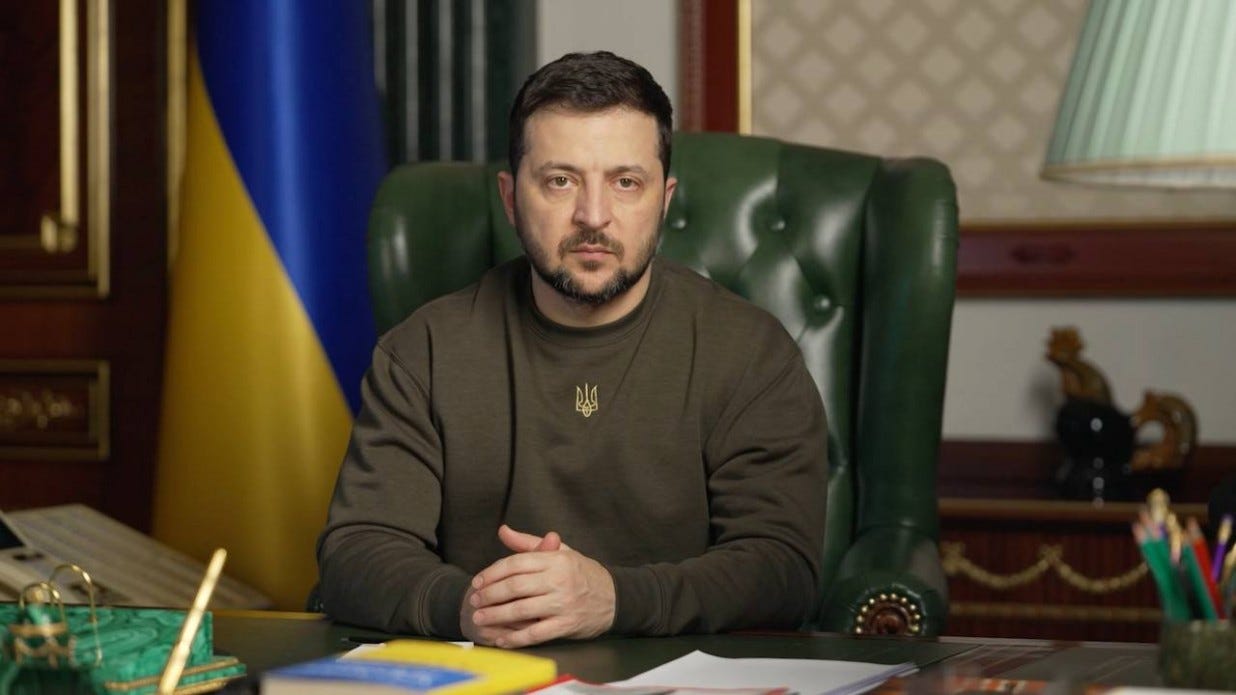
Furthermore, under an order issued by Ukraine’s Security Council, Zelenskyy seized assets from Church clergy.
The attacks seem focused on Ukrainian Orthodox Church (UOC) churches. And this, despite Reverend Mykolay Danylevich, who has often served as a spokesperson for the Ukrainian Orthodox Church, asserting that the UOC is not Russian.
Though some confusion may exist regarding which specific churches belong to the Russian or Ukrainian branches, these denominations were united at the unification council in Kyiv on December 15, 2018. In other words, they are equally recognised and classified as Eastern Orthodox Churches in the Ukraine and, in general.
It is worth noting that around two-thirds of Ukrainians identify as Eastern Orthodox Christians.
Religious freedoms are engrained in the Constitution of Ukraine.
Specifically, we find the following rights [emphasis added for clarity and relevance]:
- Article 24: Citizens have equal constitutional rights and freedoms and are equal before the law. There shall be no privileges or restrictions based on race, colour of skin, political, religious and other beliefs, sex, ethnic and social origin, property status, place of residence, linguistic or other characteristics.
- Article 35: Everyone has the right to freedom of personal philosophy and religion. This right includes the freedom to profess or not to profess any religion, to perform alone or collectively and without constraint religious rites and ceremonial rituals, and to conduct religious activity. The Church and religious organisations in Ukraine are separated from the State.
Accordingly, and with the attacks on numerous UOC churches, Ukrainian President Volodymyr Zelenskyy is clearly infringing upon these religious institutions as well as upon rights of roughly two-thirds of his country’s citizens.
Apart from independent and religious news outlets, very few mainstream media outlets have reported on this matter. Equally, apart from the Russian government, very few countries and its leaders have condemned this religious persecution.
10. Ukraine’s Systemic Corruption Problem
“Welcome to Ukraine, the most corrupt nation in Europe,” reads a Guardian long read headline from February 2015, followed by the lede “While the conflict with Russia heats up in the east, life for most Ukrainians is marred by corruption so endemic that even hospitals appear to be infected. Can anyone clean the country up?”
What is also noteworthy about this long article is that it is not presented as an opinion or commentary, but rather as a news article.
While there would be way too many aspects to cover with regards to the systemic corruption that plagues Ukraine, this author will instead highlight but a few.
One such aspect of Ukrainian society that is central to corruption is that of the oligarchy that is running the nation.
Some of these oligarchs and their abuses have been outlined in this post. In this respect, The Guardian also noted:
“Ordinary Ukrainians have seen their living standards stagnate, while a handful of oligarchs have become billionaires.”
Two other Guardian articles have outlined such corruption with the latter specifically examining the country’s governance problems.
This second article titled IMF warns Ukraine it will halt $40bn bailout unless corruption stops from 2016, highlights how the International Monetary Fund (IMF) would halt its $40 billion bailout program to Ukraine unless the country takes immediate action to tackle corruption.
“I am concerned about Ukraine’s slow progress in improving governance and fighting corruption, and reducing the influence of vested interests in policymaking,” stated Christine Lagarde who was the IMF’s managing director at the time.
By “reducing the influence of vested interests in policymaking,” the IMF chief was obviously referring to the country’s bribery problems in which oligarchs basically dictate policymaking.
Perhaps what was a little bit ironic about this (and other) statements by Christine Lagarde, who is now the current head of the European Central Bank (ECB), is that she, herself, was criminally convicted for corruption in France. It takes a crook to know one.
A September 23, 2021, press release titled EU support for reforms in Ukraine ineffective in fighting grand corruption from the European Court of Auditors commenced with “Grand corruption and state capture are still widespread in Ukraine despite EU action.”
The release continued:
“For more than 20 years, the EU has been supporting Ukraine in its reform agenda. Tackling corruption, which is a major obstacle to a country’s development and runs counter to EU values, is an integral part of that. Grand corruption and state capture are endemic in Ukraine; as well as hindering competition and growth, they also harm the democratic process. Tens of billions of euros are lost annually as a result of corruption.”
For more than 20 years the EU, and more recently, the international community, has been funnelling billions in cash and weapons into this extremely corrupt country.
According to Ukraine’s own National Agency on Corruption Prevention (NACP)section on declarations by officials, the criminal, administrative, and disciplinary offenses are too numerous for any human being to fathom. Here is a statistical summary of what their own findings indicate (Google translated):
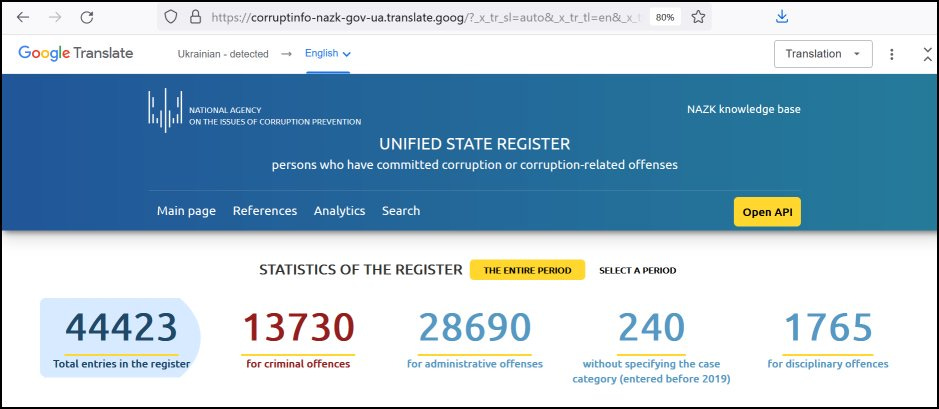
Statistics showing 13,730 instances of asset declaration-related criminal offenses, 28,690 administrative offenses, and 1,765 disciplinary offences committed by its officials. Source: Ukraine’s National Agency on Corruption Prevention (NACP)’s Unified State Register database (Google translated).
Where are all these billions going?
Sadly, as evidenced above, much of it has been pilfered by Ukraine’s ruling class, including its president.
Where are the weapons going?
This author could write another section solely devoted to examining this question. But suffice it to say that this exposition, at nearly 40 pages in length, has run long enough and has most likely worn the reader’s attention down the pits of desolate despair.
The final point to be made here comes from a Max Blumenthal tweet whereby he points out that Andrew Milburn, a retired U.S. Marine Colonel, who recently provided training for troops in the Ukraine referred to the country itself as a “corrupt, fucked-up society” run by “fucked-up people” (pardon my French).
This comes from one who is all too familiar with the inner-workings of the reality that is taking place on the ground near Russia’s borders. Having trained Ukrainian soldiers and having met many of their commanders, coupled with a deep understanding of the country’s history and culture, Milburn undoubtedly has a firm grasp about the mindset of those carrying out orders from the top.
Conclusion
While this author is no geopolitical expert or authority on the Ukraine, what has been presented above can nonetheless serve as a primer about the ugly realities that surround the country whom many deem as being on the right side of history.
Absolutely, there is no arguing that a tremendous number of Ukrainian citizens have perished, suffered, and been incredibly affected by this war with Russia, as have many Russian souls.
But it remains, nevertheless, necessary to present these inconvenient truths that have been repressed and omitted by the mainstream media, so as to offer a more complete picture of Ukraine’s own role in this conflict, along with those of NATO, the United States, Canada, and all other governments who support the former Soviet republic.
Also let this exposition serve as an exhibit for governments around the world, especially Canada, where this author resides and who believes that countless billions of our tax payer funds are carelessly being siphoned away to this corrupt Ukrainian regime rather than being put to better use for Canadians who are struggling.
Hoping this global collective madness comes to an end in 2023.
*
Note to readers: Please click the share buttons above. Follow us on Instagram and Twitter and subscribe to our Telegram Channel. Feel free to repost and share widely Global Research articles.
Featured image: Graffiti “Stop War” on Russia’s war in Ukraine in the Mauerpark in Berlin, Germany. Image taken on March 11, 2022. Source: Wikimedia Commons.

